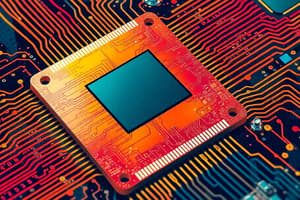Podcast
Questions and Answers
What is the impact of multiprogramming on the overall turnaround time of processes?
What is the impact of multiprogramming on the overall turnaround time of processes?
- It randomizes the overall turnaround time.
- It shortens the overall turnaround time. (correct)
- It lengthens the overall turnaround time.
- It has no impact on the overall turnaround time.
Which assumption about IO operations is made in the scenario described?
Which assumption about IO operations is made in the scenario described?
- IO operations can happen in parallel with CPU operations.
- IO operations can only occur after all CPU bursts are complete. (correct)
- IO operations are faster than CPU operations.
- IO operations are slower than CPU operations.
What is the reason behind the shortening of the overall turnaround time in multiprogramming?
What is the reason behind the shortening of the overall turnaround time in multiprogramming?
- Processes execute concurrently, allowing for overlapping CPU and IO operations. (correct)
- Processes execute sequentially, reducing the total execution time.
- IO operations are prioritized over CPU operations.
- CPU operations are faster in multiprogramming.
In a scenario where one process is in a CPU burst and another is in an IO operation, what time is saved?
In a scenario where one process is in a CPU burst and another is in an IO operation, what time is saved?
How does multiprogramming impact CPU utilization rate compared to uniprogramming?
How does multiprogramming impact CPU utilization rate compared to uniprogramming?
What happens during an overlapped period of time in a multiprogramming scenario?
What happens during an overlapped period of time in a multiprogramming scenario?
Which process's CPU burst begins first according to Formulation 1?
Which process's CPU burst begins first according to Formulation 1?
Why does the OS select one process in a CPU burst to use the CPU?
Why does the OS select one process in a CPU burst to use the CPU?
What is a benefit of having a multi-programming scenario?
What is a benefit of having a multi-programming scenario?
Which assumption allows for selecting another process for CPU burst when the current one is doing IO operations?
Which assumption allows for selecting another process for CPU burst when the current one is doing IO operations?
Flashcards
Turnaround Time
Turnaround Time
The time taken from process submission to completion.
Multiprogramming
Multiprogramming
A system where multiple processes share a single CPU and run concurrently.
CPU Burst
CPU Burst
The time spent by a process actively using the CPU.
I/O Burst
I/O Burst
Signup and view all the flashcards
Overlapping Operations
Overlapping Operations
Signup and view all the flashcards
CPU Utilization Rate
CPU Utilization Rate
Signup and view all the flashcards
Assumption #1
Assumption #1
Signup and view all the flashcards
Assumption #2
Assumption #2
Signup and view all the flashcards
Time saved by Multiprogramming
Time saved by Multiprogramming
Signup and view all the flashcards
Impact of Multiprogramming on Turnaround Time
Impact of Multiprogramming on Turnaround Time
Signup and view all the flashcards
Study Notes
Uni-programming System
- In a uni-programming system, only one process is allowed to execute at a time, and the execution of the next process begins only after the previous one has completed.
- CPU utilization rate is the proportion of time the CPU is doing useful work, which is 25% of the time in this case.
- Overall turnaround time is the total time taken for all three processes to complete their execution, which is the sum of individual process's turnaround time.
- In the given example, the overall turnaround time is 4 + 12 + 16 = 32 ms.
Characteristics of Processes
- Process A, B, and C have turnaround times of 4, 12, and 16 ms, respectively.
- Each process spends 25% of the time in CPU bursts and 75% in IO bursts.
CPU Utilization Rate
- The CPU utilization rate is not affected by the order of execution of the three processes in a uni-programming system.
- The CPU utilization rate is 25% in this case, which is calculated by the total time the CPU is being used divided by the overall turnaround time.
Multi-programming System
- In a multi-programming system, the OS can execute multiple processes at the same time, and the CPU utilization rate is improved.
- Assumptions in a multi-programming system include:
- Ignoring the time taken by the OS to do work in executing the processes.
- IO operations cannot happen in parallel.
- For each process, CPU burst must happen first.
- The OS will execute all processes at the same time, and when one process is doing IO operations, the OS will select another process in CPU burst to use the CPU.
- The overall turnaround time is shorter in a multi-programming system due to the overlapped period of time when one process is doing CPU and another is doing IO.
Studying That Suits You
Use AI to generate personalized quizzes and flashcards to suit your learning preferences.
Related Documents
Description
Calculate the CPU utilization rate and the overall turnaround time of three processes (A, B, and C) with specific characteristics when only one process is allowed to execute at a time (uni-programming). The processes have defined turn-around times, CPU burst and IO burst times.





